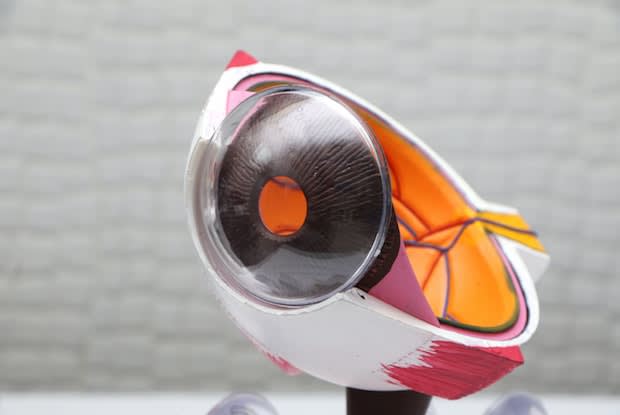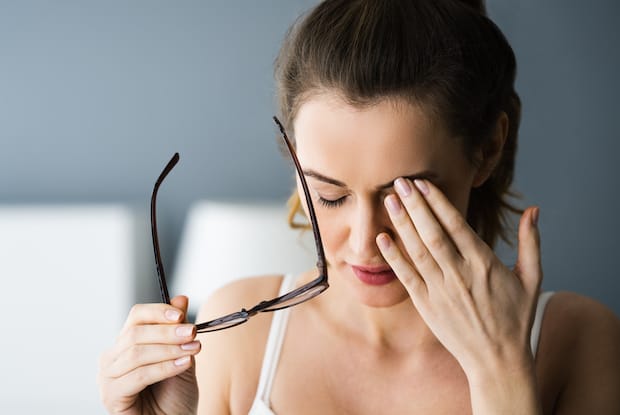Table of Contents
II. Most Common Types of Glaucoma
What is Glaucoma?
Many people think of glaucoma as a disorder of older adults, but it can affect people as young as 40 years old. Glaucoma is the leading cause of irreversible blindness in the United States, with over 3 million adults living with this condition.[1]
Since it is so prevalent, many people do not take it seriously and can end up with permanent vision problems if it is not treated with medications like Lumigan. Glaucoma is a group of eye disorders that leads to damage of the optic nerve, which is a group of nerve fibers that carry information from the eye to the brain. If this nerve is damaged, it can result in vision loss or blindness. [1]
Contrary to popular belief, glaucoma is not always caused by increased eye pressure. Glaucoma can occur in adults with normal or even lower than normal eye pressure. You may be at risk for glaucoma if you are over 60 years old, have a family history of glaucoma, or have internal eye pressure. Read on to learn more about the signs and symptoms of glaucoma.
Researchers have found that there are many different types of glaucoma that can affect a person’s vision. But in general, there are two main types that affect the majority of glaucoma sufferers. Those two include: Primary Open-Angle Glaucoma (POAG): This type of glaucoma is the most common. Doctors often describe POAG as the “silent thief of sight” because there are typically few warning signs in the early stages. [2] POAG is caused by an imbalance in the production and drainage of clear fluid that fills the space between the cornea and iris. When these drainage channels become blocked, pressure in the eye increases to dangerous levels. This pressure pushes against the optic nerve, which deprives the nerve of oxygen and nutrients. People with this type of glaucoma begin to lose their peripheral vision, so they may not see a car in a passing lane or begin to bump into doorways. If this type is left untreated, you can experience optic eye nerve damage and vision loss. [2] Angle-Closure Glaucoma: This type is less prevalent, but is the second most common type of glaucoma. [3] Angle-closure, also known as narrow-angle, occurs when the drainage canals of the eye are blocked, resulting in eye pressure. It occurs suddenly when the iris (colored portion of the eye) is pushed forward. Unlike POAG, this form requires immediate attention. Angle-closure symptoms are much more noticeable and often painful, so they require immediate care from an ophthalmologist. With each attack of angle-closure glaucoma, you can steadily lose your vision. If your eye pressure is not quickly reduced, you may go blind. [3] Glaucoma can be tricky because it typically does not start with many symptoms at all. Over half of people with this eye condition do not even know they have it. Those with glaucoma may slowly start to lose vision, starting with the peripheral (side) vision. The vision changes begin so slowly that most people do not even realize that they are not seeing as well. For many people, they only realize they have a problem when they notice they cannot see things to the side anymore. [2] There are several different types of glaucoma and the symptoms depend on the type and stage of your condition. Primary Open-Angle Glaucoma Symptoms: Acute Angle-Closure Glaucoma Symptoms: For many with POAG, they will not seek medical treatment until their vision is severely affected. Alternatively, angle-closure symptoms are so apparent that emergency treatment is sought quickly. Regardless of your type of glaucoma, your doctor will go over your medical history and perform several tests. Typically, an annual optometrist visit can catch any eye problems before they become severe. Doctors will typically: Treatment for glaucoma depends on the severity and type of glaucoma you have. The initial treatment for glaucoma starts with prescription eye drops which can improve how fluid drains from the eyes. Prescription drops can also decrease the amount of fluid your eye makes. There are several different types of eye drop medications available and the most common types include: Prostaglandins: Prostaglandins are groups of lipids that are involved in dealing with injury and illness. They help control blood flow, inflammation, and formation of blood clots. This type of medication works by increasing the outflow of the fluid in the eye and reducing eye pressure. These drugs typically only need to be used once a day. Lumigan is one commonly prescribed prostaglandin eye drop. Side effects of these drugs can include stinging in the eyes, darkening of the iris, blurred vision, and darkening of eyelash pigment. [3] Beta-Blockers: Beta-blockers can help reduce the production of fluid in the eye, which lowers intraocular pressure. Beta-blockers may result in side effects like slowed heart rate, lower blood pressure, and fatigue. Alpha-adrenergic Agonists: These drugs reduce the production of the aqueous humor, which then increases the outflow of fluid in the eye. This drug is used twice a day to prevent glaucoma symptoms. [4] Carbonic Anhydrase Inhibitors: This drug decreases the secretion of aqueous humor, which is the clear fluid that fills the space between the lens and cornea of the eyeball. This results in the reduction of pressure in the eyes. Each eye drop medicine may have different side effects. You can minimize the absorption of the drug by closing your eyes for one to two minutes after putting the drops in. After putting the drops in, press lightly at the corner of your eyes near your nose for one to two minutes. After applying, wipe unused drops from the eyelid. Talk to your doctor about how much time to wait between administering different eye drop medications. [5] When you have advanced glaucoma, surgery may be necessary to improve vision and stave off the deteriorating effects of this condition. Some common surgeries for glaucoma can include: Laser Therapy: Your doctor may perform laser trabeculoplasty if you have open-angle glaucoma. This procedure is done in a doctor’s office. This laser surgery involves a small laser beam that opens clogged channels in the trabecular meshwork, which is the tissue located behind the base of the cornea. The effects of this procedure may take a few weeks to show its full effect. If you have angle-closure glaucoma, then your doctor creates a small opening in the iris using a laser, which allows fluid to flow through the opening. [4] Drainage Tubes: This procedure involves inserting a small tube in the eye to drain away excess fluid to reduce eye pressure. This surgery is used to control eye pressure if previous surgeries or procedures are unsuccessful. Minimally Invasive Glaucoma Surgery (MIGS): This type of procedure requires less postoperative care than the above surgeries. MIGS also have less risk than a trabeculectomy (eye pressure-reducing procedures) or a drainage device. There are a number of MIGS techniques available. Your doctor will let you know which procedure is right for you. [4] The content in this article is intended for informational purposes only. This website does not provide medical advice. In all circumstances, you should always seek the advice of your physician and/or other qualified health professionals(s) for drug, medical condition, or treatment advice. The content provided on this website is not a substitute for professional medical advice, diagnosis or treatment.
Most Common Types of Glaucoma
Symptoms of Glaucoma

Diagnosing Glaucoma
Medications for Glaucoma

Surgeries
